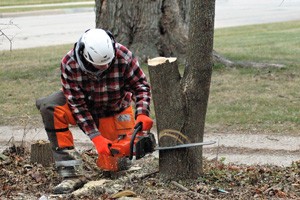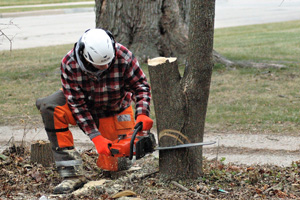Gateway Technical College Arboriculture program student Sam Braun says the project he and his classmates participated in Monday offered students two opportunities – to give and to receive.
Braun and his Chainsaw Safety classmates gave their time and used the skills learned in the program to fell and clear trees at a Habitat for Humanity site in Kenosha. What they gained was a way to give back while continuing to hone the skills they need for their future career.
“This is really awesome,” said Braun. “We have an opportunity to not only utilize the skills we are learning, but also helping out the community in a real, pro-active way. It’s very cool.
“This is real-world stuff. This is what a job site would look like, and we are doing this for two families who will now have a home. It’s really cool because we will be able to drive or walk past here in years to come and say, ‘Oh, hey, I helped clear that land.’”
Students felled, bucked, limbed and chipped a number of trees at the site where two Habitat homes will be built next year. Pruning of the remaining trees will also provide service opportunities for future program students.
Instructor and Arboriculture/Urban Forestry director Aaron Schauer said working on the Habitat project gives students the opportunity to work with a community service group while also honing the skills they will need in their future careers.
“I view this as an opportunity for us to give back to the community, to help those who may be less fortunate,” says Schauer. “It’s a great time of the year to do this, to show the community that we care.
“It’s also a great opportunity for students to get the experience of felling a tree and honing those other skills. We can’t just go around our campus cutting down trees, so we are always looking for ways for students to gain that experience in the community. Due to the nature of our classroom needs, we always focus our community on nonprofits or government entities, both of whom are always short on funds for tree care.”
Habitat for Humanity of Kenosha Executive Director Angela Elliott said they typically pay a professional for tree removal at the site, so the work done by the student definitely benefited her group.
“We thought this would be a great opportunity for the students to be able to use the skills they’ve learned in the class to help Habitat by donating their service and time,” said Elliott.
“It’s a win-win. Students get to hone their skills and it helps us to be able to have some work done that we need to be able to build the house. It’s a great benefit for everyone.”
Schauer said the site also gave him the opportunity to show students in a real-world setting how to address protecting the existing trees during the construction process as well, something they will have to do in their future career.
“It’s important to address how to protect trees before construction happens,” said Schauer. “People don’t often consult an arborist during the process, when they should. You have trees that die a few years after a home is built because of the heavy equipment that’s driven over it during the building process, or piles of material and soil placed on it.
“Five to 10 years later and you have a dead tree you have to remove, sometimes close to the home. Today was a great way to further show the students how to address those issues and which trees to protect.”
This is the second time Gateway students have partnered with Habitat on this specific project – the two homes to be built were designed by Gateway students.


